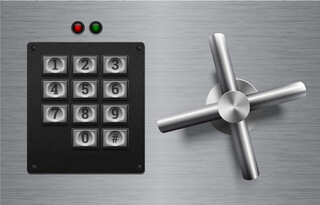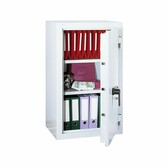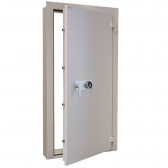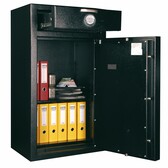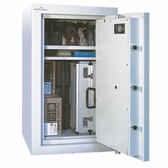Key lock, combination lock or maybe fingerprint opening? When buying a safe, you probably wonder which lock to choose. Both the owner's preferences and the value of the items deposited in the safe, and thus the class of the safe, are important. We check what the various types of popular safe locks are characterised by.
Nowadays, anyone who needs a solid safe deposit box for valuable items can choose the right safe for themselves. There are so many available models that we can successfully match the appropriate burglary resistance class, size, equipment or even appearance. An extremely important issue is also the type of lock, which is one of the most important safeguards. Sometimes the choice of a suitable lock is narrowed down by class requirements and related regulations. A single lock is not always enough for a safe, sometimes a combination of at least two locks is required for high security.
Popular safe locks
A common type of safe lock chosen for home and office lockers is the traditional key lock. This is a robust and low-failure security device, but it does require you to remember to store the key properly so that no unauthorised person has access to it. This can sometimes be problematic as the key to a safe lock can be as long as a dozen or so centimetres. The biggest advantage of key locks is the ease of use, no need to remember the code or power the safe.
A safe with a mechanical combination lock
Safes with a mechanical combination lock are equipped with a special knob, which opens the lock after selecting the appropriate sequence of digits. Although operating the dial requires skill and precision, and involves memorising a pre-configured code, there is no need to carry a key. A safe with a combination lock and a dial is also an effective security measure, as it is difficult for a potential thief or outsiders to "intercept" the code, for example with the help of a camera installed and hidden in the room. This type of lock is particularly recommended for safes in private homes, where it is the owner who deposits items in the box and does not have to open it frequently during the day. Its greatest advantage is that it does not require batteries or power supply. It is therefore an eco-friendly lock, producing no waste during use. However, it should be remembered that it is also a lock that requires great precision when entering the code.
If you are interested in buying a safe check out our range of safes for home.
A safe with an electronic lock
On the other hand, a safe with an electronic combination lock will work better in offices and companies – for example in hotels, shops or restaurants. This type of lock requires the code to be memorised and the safe is opened by entering it on the keypad. This activity can even be streamlined and the entering of the code can be omitted by using the proximity function. In this case, it is enough to hold a special card, key ring or bracelet against the lock. Electronic locks also make it possible to integrate a safe with, for example, a home alarm system, which increases the level of security. Sometimes it is even recommended to use the function of a safe with a time lock. Then, even after entering the code, e.g. under pressure from a burglar, the safe will open with a delay, which gives time, e.g. for the alarm system to automatically notify security services and their arrival on site. Although, unlike mechanical locks, every electronic lock requires battery power, there is no need to be "afraid" of electronics, because approved locks inform about the battery status and allow for external power supply.
A safe with a biometric lock
Biometric locks, which allow the safe to be opened with a fingerprint, offer yet another possibility. This solution is a great convenience, as it allows the safe to be opened quickly without having to remember the code and at the same time provides a high level of security in both homes and businesses. The lock is configured by entering the appropriate pattern of scanned fingerprints of one or more fingers into the safe's system. This type of electronic lock does not require battery power, as the safe is powered from the home mains.
Open the safe with a smartphone
An innovative way to access a safe is to open it using a smartphone. This type of product is offered by Hartmann Tresore, a pioneer in this field. Instead of having a keypad on the safe, you can use the one you already have on your phone. The same goes for the fingerprint reader. Your smartphone will connect via Bluetooth to the safe and, after authentication, unlock the lock. Is it safe to open the safe with your mobile? Just like logging into your online bank account – the same technology has been used in both cases. It is so secure and proven that you do not lose anything even if you lose your smartphone. The digital keys to the safe always remain with you.
Opening a safe with your smartphone is particularly convenient if you share safes with other users in your home or office and want to manage access to them in real time: you can grant or revoke permissions at any time and at any time with a single touch of the screen. You can also be informed when the safe is opened and give your consent in real time ("intercom" function). What's more, you can use the same technology to open your front door, garage door or barrier. You can also grant service technicians or cleaners restricted access on specific days at specific times without having to hand over or collect cards or tokens. If you already have access control, you can easily improve its functionality and take complete control over access.
When considering whether to choose an electronic, keyed or smartphone opening safe, it is worth considering both your current and future needs. It is important to remember that replacing locks is possible in most cases, but often involves costs that exceed the surcharge for a more advanced lock when buying a safe. Regardless of individual habits or preferences, it is worth following the development of technology, which opens up completely new possibilities.
It may be interesting for you: How to open a safe? Ways of opening different locks
How to open a safe equipped with a mechanical and electronic lock?
